HONDA PRELUDE 1998 Owners Manual
Manufacturer: HONDA, Model Year: 1998, Model line: PRELUDE, Model: HONDA PRELUDE 1998Pages: 278, PDF Size: 2.61 MB
Page 181 of 278
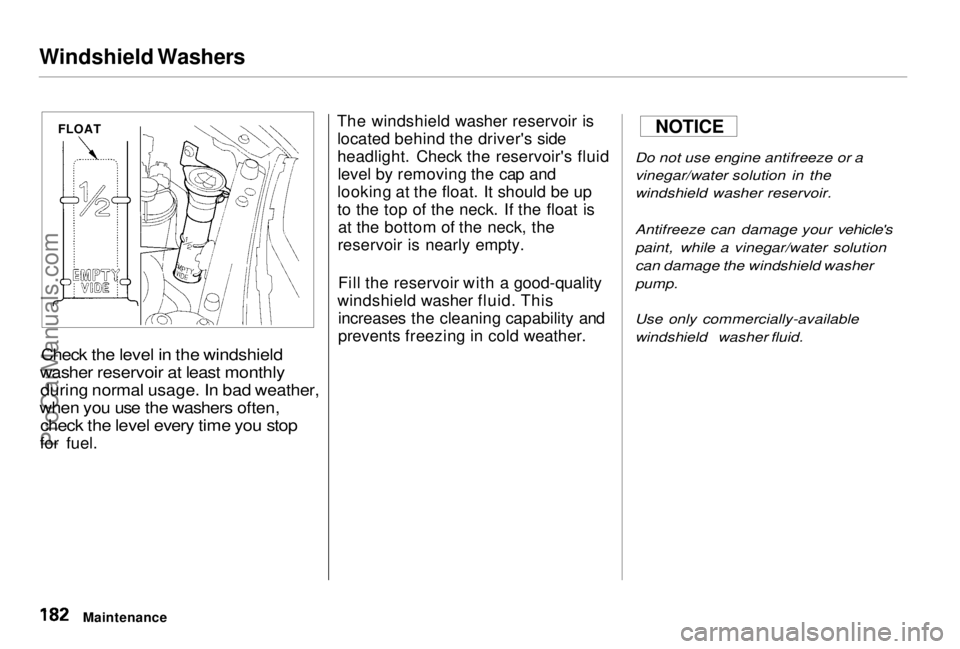
Windshield Washers
Check the level in the windshield
washer reservoir at least monthly
during normal usage. In bad weather,
when you use the washers often,
check the level every time you stop
for fuel. The windshield washer reservoir is
located behind the driver's side
headlight. Check the reservoir's fluidlevel by removing the cap and
looking at the float. It should be up
to the top of the neck. If the float is at the bottom of the neck, the
reservoir is nearly empty.
Fill the reservoir with a good-quality
windshield washer fluid. This increases the cleaning capability and
prevents freezing in cold weather.
Do not use engine antifreeze or a
vinegar/water solution in the
windshield washer reservoir.
Antifreeze can damage your vehicle's
paint, while a vinegar/water solution
can damage the windshield washer
pump.
Use only commercially-available
windshield washer fluid.
Maintenance
NOTICE
FLOATProCarManuals.comMain Menu Table of Contents s t
Page 182 of 278
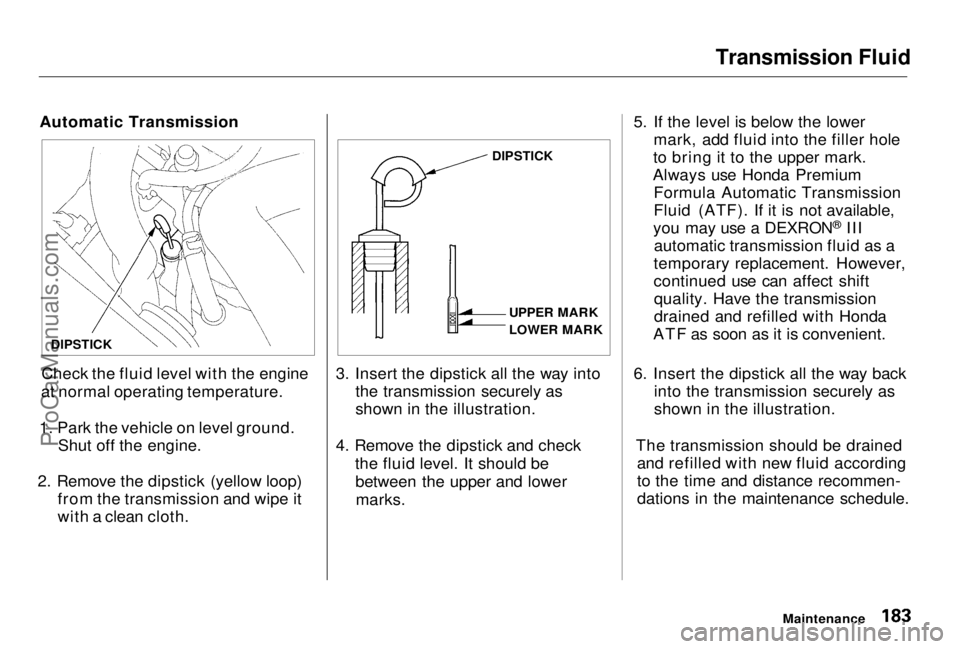
Transmission Fluid
Automatic Transmission
Check the fluid level with the engine
at normal operating temperature.
1. Park the vehicle on level ground. Shut off the engine.
2. Remove the dipstick (yellow loop) from the transmission and wipe it
with a clean cloth. 3. Insert the dipstick all the way into
the transmission securely as
shown in the illustration.
4. Remove the dipstick and check the fluid level. It should bebetween the upper and lowermarks. 5. If the level is below the lower
mark, add fluid into the filler hole
to bring it to the upper mark.
Always use Honda Premium Formula Automatic Transmission
Fluid (ATF). If it is not available,
you may use a DEXRON ®
III
automatic transmission fluid as a
temporary replacement. However,
continued use can affect shift quality. Have the transmission
drained and refilled with Honda
ATF as soon as it is convenient.
6. Insert the dipstick all the way back into the transmission securely as
shown in the illustration.
The transmission should be drained and refilled with new fluid according
to the time and distance recommen-
dations in the maintenance schedule.
Maintenance
DIPSTICK
UPPER MARK
LOWER MARK
DIPSTICKProCarManuals.comMain Menu Table of Contents s t
Page 183 of 278
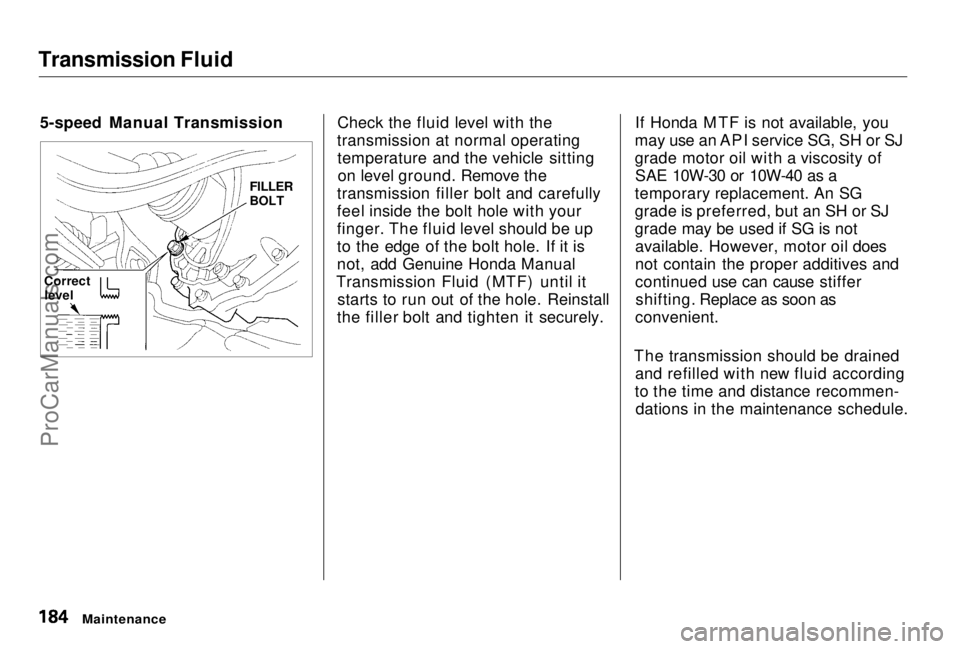
Transmission Fluid
5-speed Manual Transmission Check the fluid level with the
transmission at normal operating temperature and the vehicle sittingon level ground. Remove the
transmission filler bolt and carefully
feel inside the bolt hole with your
finger. The fluid level should be up
to the edge of the bolt hole. If it is
not, add Genuine Honda Manual
Transmission Fluid (MTF) until it starts to run out of the hole. Reinstall
the filler bolt and tighten it securely. If Honda MTF is not available, you
may use an API service SG, SH or SJ
grade motor oil with a viscosity of SAE 10W-30 or 10W-40 as a
temporary replacement. An SG
grade is preferred, but an SH or SJ
grade may be used if SG is not available. However, motor oil does
not contain the proper additives and
continued use can cause stiffershifting. Replace as soon as
convenient.
The transmission should be drained and refilled with new fluid according
to the time and distance recommen- dations in the maintenance schedule.
Maintenance
Correct
level
FILLER
BOLTProCarManuals.comMain Menu Table of Contents s t
Page 184 of 278

Brake and Clutch Fluid
Check the fluid level in the reser-
voirs monthly. There are up to two reservoirs, depending on model.
They are: Brake fluid reservoir (all models)
Clutch fluid reservoir
(manual transmission only)
The brake fluid in the brake system should be replaced according to the
time and distance recommendations
in the maintenance schedule. Always use Genuine Honda DOT 3
brake fluid. If it is not available, youshould use only DOT 3 or DOT 4
fluid, from a sealed container, as a
temporary replacement. However,
the use of any non-Honda brake fluid can cause corrosion and decrease
the life of the system. Have the brake system flushed and refilled
with Honda DOT 3 brake fluid as soon as possible.
Brake fluid marked DOT 5 is not
compatible with your vehicle's
braking system and can cause extensive damage. Brake System
MAX
The fluid level should be between the MIN and MAX marks on the sideof the reservoir. If the level is at or
below the MIN mark, your brake system needs attention. Have the
brake system inspected for leaks or worn brake pads.
Maintenance
MINProCarManuals.comMain Menu Table of Contents s t
Page 185 of 278
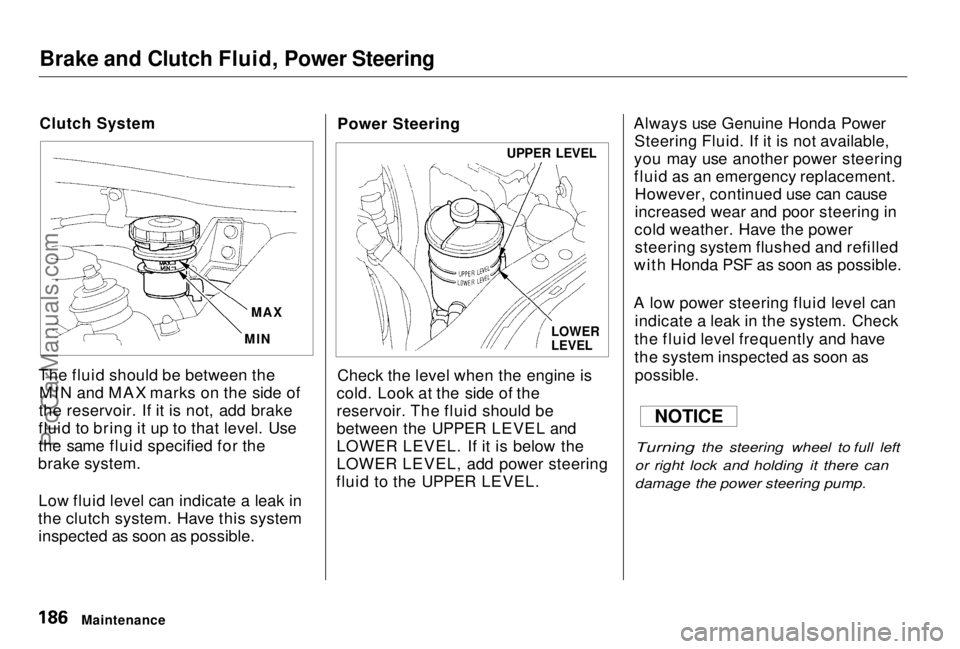
Brake and Clutch Fluid, Power Steering
Clutch System
The fluid should be between the MIN and MAX marks on the side of
the reservoir. If it is not, add brake
fluid to bring it up to that level. Use
the same fluid specified for the
brake system.
Low fluid level can indicate a leak in
the clutch system. Have this system inspected as soon as possible. Power Steering
Check the level when the engine is
cold. Look at the side of the
reservoir. The fluid should be
between the UPPER LEVEL and
LOWER LEVEL. If it is below the
LOWER LEVEL, add power steering
fluid to the UPPER LEVEL. Always use Genuine Honda Power
Steering Fluid. If it is not available,
you may use another power steering
fluid as an emergency replacement. However, continued use can cause
increased wear and poor steering in
cold weather. Have the power steering system flushed and refilled
with Honda PSF as soon as possible.
A low power steering fluid level can indicate a leak in the system. Check
the fluid level frequently and have
the system inspected as soon as
possible.
Turning the steering wheel to full left
or right lock and holding it there can
damage the power steering pump.
Maintenance
MAX
MIN
LOWER
LEVEL
UPPER LEVEL
NOTICE
ProCarManuals.comMain Menu Table of Contents s t
Page 186 of 278
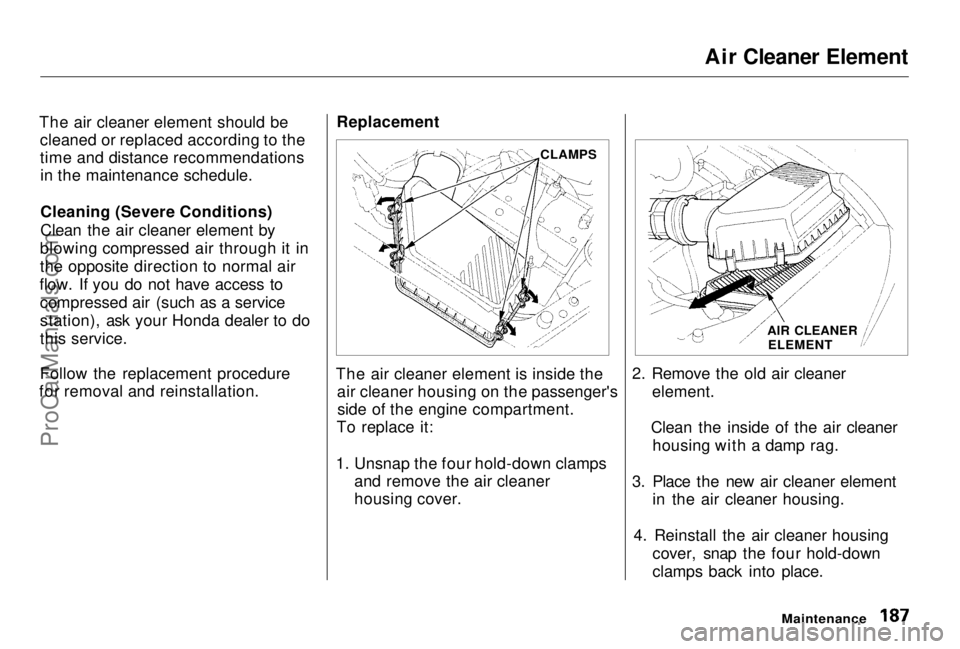
Air Cleaner Element
The air cleaner element should be cleaned or replaced according to the
time and distance recommendationsin the maintenance schedule.
Cleaning (Severe Conditions)
Clean the air cleaner element by
blowing compressed air through it in
the opposite direction to normal air
flow. If you do not have access to compressed air (such as a service
station), ask your Honda dealer to do
this service.
Follow the replacement procedure
for removal and reinstallation. Replacement
The air cleaner element is inside the air cleaner housing on the passenger'sside of the engine compartment.
To replace it:
1. Unsnap the four hold-down clamps and remove the air cleaner
housing cover.
AIR CLEANER
ELEMENT
2. Remove the old air cleaner element.
Clean the inside of the air cleaner housing with a damp rag.
3. Place the new air cleaner element in the air cleaner housing.
4. Reinstall the air cleaner housing cover, snap the four hold-down
clamps back into place.
Maintenance
CLAMPSProCarManuals.comMain Menu Table of Contents s t
Page 187 of 278
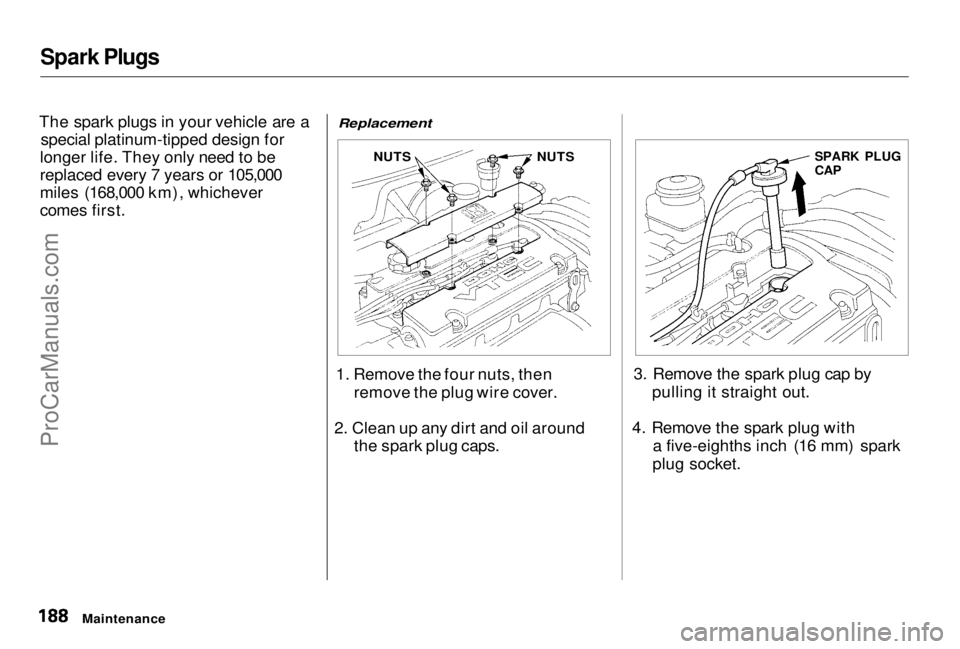
Spark Plugs
The spark plugs in your vehicle are a special platinum-tipped design for
longer life. They only need to be
replaced every 7 years or 105,000
miles (168,000 km), whichever
comes first.
Replacement
1. Remove the four nuts, then remove the plug wire cover.
2. Clean up any dirt and oil around the spark plug caps. 3. Remove the spark plug cap by
pulling it straight out.
4. Remove the spark plug with a five-eighths inch (16 mm) spark
plug socket.
Maintenance
SPARK PLUG
CAP
NUTS
NUTSProCarManuals.comMain Menu Table of Contents s t
Page 188 of 278
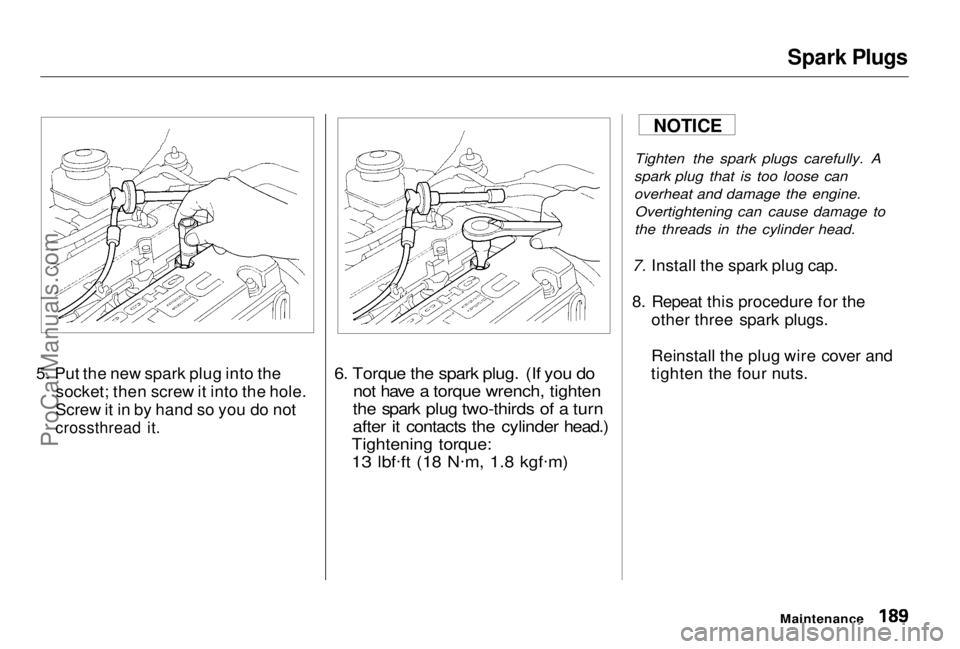
Spark Plugs
5. Put the new spark plug into the socket; then screw it into the hole.
Screw it in by hand so you do not
crossthread it.
6. Torque the spark plug. (If you do
not have a torque wrench, tighten
the spark plug two-thirds of a turn
after it contacts the cylinder head.)
Tightening torque:
13 lbf .
ft (18 N .
m, 1.8 kgf .
m)
Tighten the spark plugs carefully. A
spark plug that is too loose can
overheat and damage the engine. Overtightening can cause damage to
the threads in the cylinder head.
7. Install the spark plug cap.
8. Repeat this procedure for the other three spark plugs.
Reinstall the plug wire cover and
tighten the four nuts.
Maintenance
NOTICE
ProCarManuals.comMain Menu Table of Contents s t
Page 189 of 278
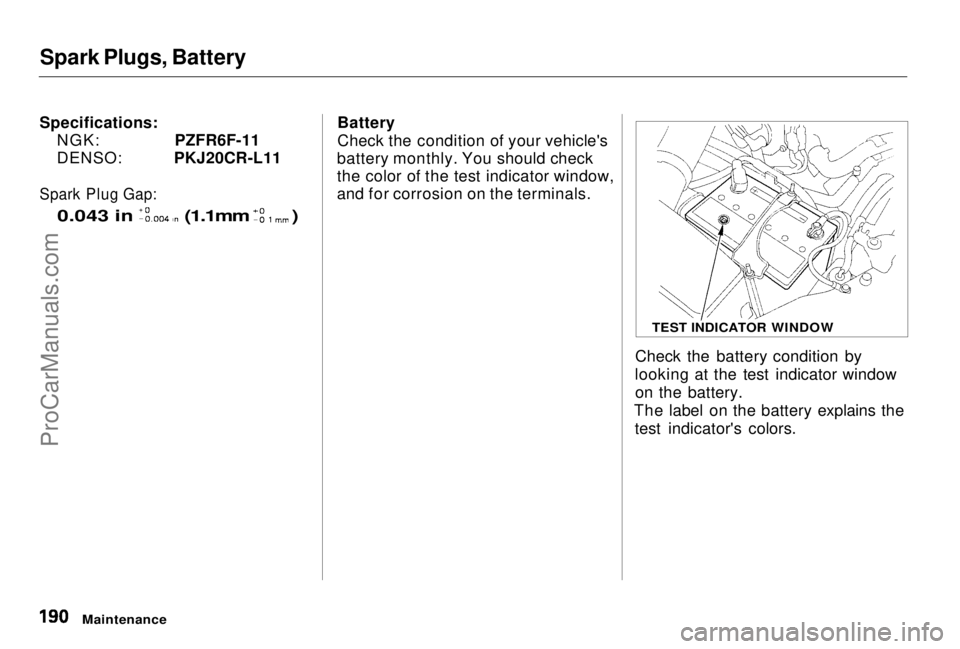
Spark Plugs, Battery
Specifications: NGK: PZFR6F-11
DENSO: PKJ20CR-L11
Spark Plug Gap:
0.043 in (1.1mm )
Battery
Check the condition of your vehicle's
battery monthly. You should check
the color of the test indicator window,
and for corrosion on the terminals.
Check the battery condition by
looking at the test indicator window on the battery.
The label on the battery explains the test indicator's colors.
Maintenance
TEST INDICATOR WINDOWProCarManuals.comMain Menu Table of Contents s t
Page 190 of 278
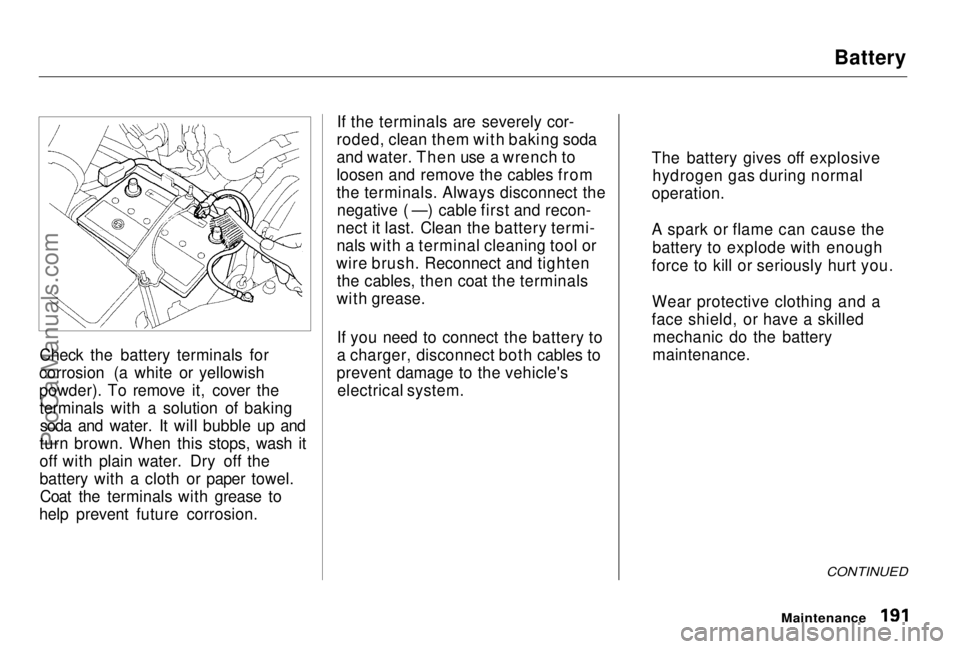
Battery
Check the battery terminals for
corrosion (a white or yellowish
powder). To remove it, cover the terminals with a solution of bakingsoda and water. It will bubble up and
turn brown. When this stops, wash it
off with plain water. Dry off the
battery with a cloth or paper towel. Coat the terminals with grease to
help prevent future corrosion. If the terminals are severely cor-
roded, clean them with baking soda
and water. Then use a wrench to
loosen and remove the cables from
the terminals. Always disconnect the negative ( —) cable first and recon-
nect it last. Clean the battery termi-
nals with a terminal cleaning tool or
wire brush. Reconnect and tighten the cables, then coat the terminals
with grease.
If you need to connect the battery to
a charger, disconnect both cables to
prevent damage to the vehicle's electrical system.
CONTINUED
Maintenance
The battery gives off explosive
hydrogen gas during normal
operation.
A spark or flame can cause the
battery to explode with enough
force to kill or seriously hurt you.
Wear protective clothing and a
face shield, or have a skilled mechanic do the battery
maintenance.ProCarManuals.comMain Menu Table of Contents s t